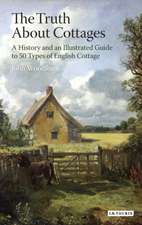The Georgian London Town House: Building, Collecting and Display
Editat de Dr Kate Retford, Dr Susanna Avery-Quashen Limba Engleză Hardback – 6 mar 2019
| Toate formatele și edițiile | Preț | Express |
|---|---|---|
| Paperback (1) | 182.41 lei 3-5 săpt. | +50.78 lei 7-13 zile |
| Bloomsbury Publishing – 17 mar 2021 | 182.41 lei 3-5 săpt. | +50.78 lei 7-13 zile |
| Hardback (1) | 893.09 lei 6-8 săpt. | |
| Bloomsbury Publishing – 6 mar 2019 | 893.09 lei 6-8 săpt. |
Preț: 893.09 lei
Preț vechi: 1223.41 lei
-27% Nou
Puncte Express: 1340
Preț estimativ în valută:
170.92€ • 177.08$ • 142.64£
170.92€ • 177.08$ • 142.64£
Carte tipărită la comandă
Livrare economică 22 martie-05 aprilie
Preluare comenzi: 021 569.72.76
Specificații
ISBN-13: 9781501337291
ISBN-10: 1501337297
Pagini: 364
Ilustrații: 32 colour and 60 bw illus - integrated
Dimensiuni: 152 x 229 mm
Greutate: 0.89 kg
Editura: Bloomsbury Publishing
Colecția Bloomsbury Visual Arts
Locul publicării:New York, United States
ISBN-10: 1501337297
Pagini: 364
Ilustrații: 32 colour and 60 bw illus - integrated
Dimensiuni: 152 x 229 mm
Greutate: 0.89 kg
Editura: Bloomsbury Publishing
Colecția Bloomsbury Visual Arts
Locul publicării:New York, United States
Caracteristici
Showcases
cutting-edge
scholarship
on
a
range
of
London
town
houses.
The
reader
will
not
only
learn
more
about
London
town
houses
owned
by
the
aristocracy,
but
also
about
the
homes
of
aspiring
merchants
and
professionals.
They
will
see
the
ways
in
which
the
particular
concerns
and
interests
of
these
various
owners
were
reflected
in
choices
of
decoration,
furniture
and
collections,
and
in
the
ways
in
which
spaces
were
utilised
and
certain
categories
of
visitor
welcomed
Cuprins
PrefaceSir
Nicholas
PennyAcknowledgementsMap:
Locations
of
the
Principal
Georgian
London
town
houses
Discussedin
this
book
List
of
illustrationsIntroductionKate
RetfordPart
One:
Architecture,
Furnishing,
Decorating1.
A
House
Divided:
Building
Biographies
and
the
Town
House
in
Georgian
London,Matthew
Jenkins
and
Charlotte
Newman2.
'You
never
saw
such
a
scene
of
magnificence
and
taste':
Norfolk
House
after
its
Grand
Reopening
in
1756,Jeremy
Howard3.
The
Refurbishment
of
Northumberland
House:
Craftsmen
and
Interior
Decoration
in
Mid-Eighteenth-Century
London
Town
Houses,Adriano
Aymonino
and
Manolo
Guerci4.
Town
and
Country:
The
Spencers
of
Althorp,Joseph
Friedman5.
The
Regency
Transformation
of
Burlington
House,
Piccadilly:
The
Architectural
Drawings
of
Samuel
Ware
in
the
Royal
Academy
of
Arts,Neil
BinghamPart
Two:
Buying,
Collecting,
Display6.
The
Display
and
Reception
of
Private
Picture
Collections
in
London
Town
Houses,
1780-1830,Susannah
Homer7.
Superb
Cabinets
or
Splendid
Anachronisms?
Anatomy,
Natural
History
and
Fine
Arts
in
the
London
Town
House,Helen
McCormack8.
Artist
in
Residence:
Joshua
Reynolds
at
No
47,
Leicester
Fields,Donato
Esposito9.
The
Pictures
at
Carlton
House,Desmond
Shawe
Taylor10.
Glitter
and
fashion
in
the
'Louvre
of
London':
Animating
Cleveland
House,Anne
Nellis
Richter11.
John
Julius
Angerstein
and
the
Development
of
his
Art
Collection
at
No
100,
Pall
Mall,
London,Susanna
Avery-QuashAfterwordJoseph
Friedman
and
Susanna
Avery-QuashSelect
Bibliography
Picture
credits
Index
Recenzii
"Visually thrilling and engaging throughout, this collection makes a timely intervention in several fields, and will probably become a cornerstone text for scholars working across architectural history, material culture, social history, history of collecting and art history. Signposting archival and museum resources alongside compelling methodological frameworks, The Georgian London Town House issues a rallying cry for future scholarship and proposes exciting and myriad ways in which we might look to reanimate these previously obscured worlds."
A major contribution to scholarship, mostly well written and carefully edited ... The book is generally attractive and well produced.
A major contribution to scholarship, mostly well written and carefully edited ... The book is generally attractive and well produced.














![Encyclopedia of Detail in Contemporary Residential Architecture [With CDROM]: Understanding & Using Light in Art & Design](https://i2.books-express.ro/bt/9781856696920/encyclopedia-of-detail-in-contemporary-residential-architecture-with-cdrom.jpg)
